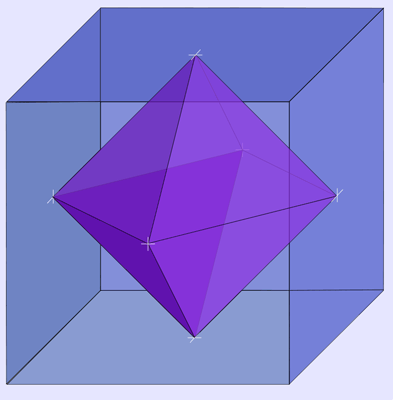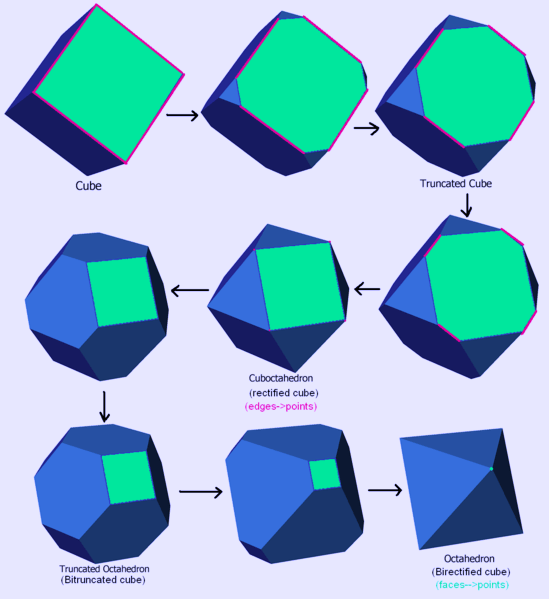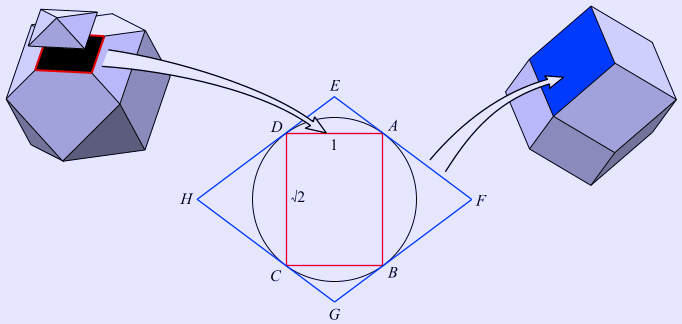.
Dual polyhedron

The dual of a cube as an octahedron with vertices at the cube face centers. (*)
In geometry, polyhedra are associated into pairs called duals, where the vertices of one correspond to the faces of the other. The dual of the dual is the original polyhedron. The dual of a polyhedron with equivalent vertices is one with equivalent faces, and of one with equivalent edges is another with equivalent edges. So the regular polyhedra — the Platonic solids and Kepler-Poinsot polyhedra — are arranged into dual pairs, with the exception of the regular tetrahedron which is self-dual.
Duality is also sometimes called reciprocity or polarity.
Kinds of duality
There are many kinds of duality. The kinds most relevant to polyhedra are:
* Polar reciprocity
* Topological duality
* Abstract duality
Polar reciprocation
Duality is most commonly defined in terms of polar reciprocation about a concentric sphere. Here, each vertex (pole) is associated with a face plane (polar plane or just polar) so that the ray from the center to the vertex is perpendicular to the plane, and the product of the distances from the center to each is equal to the square of the radius. In coordinates, for reciprocation about the sphere
x2 + y2 + z2 = r2,
the vertex
(x0,y0,z0)
is associated with the plane
x0x + y0y + z0z = r2.
The vertices of the dual, then, are the poles reciprocal to the face planes of the original, and the faces of the dual lie in the polars reciprocal to the vertices of the original. Also, any two adjacent vertices define an edge, and these will reciprocate to two adjacent faces which intersect to define an edge of the dual.
Notice that the exact form of the dual will depend on what sphere we reciprocate with respect to; as we move the sphere around, the dual form distorts. The choice of center (of the sphere) is sufficient to define the dual up to similarity. If multiple symmetry axes are present, they will necessarily intersect at a single point, and this is usually taken to be the center. Failing that a circumscribed sphere, inscribed sphere, or midsphere (one with all edges as tangents) can be used.
If a polyhedron has an element passing through the center of the sphere, the corresponding element of its dual will go to infinity. Since traditional "Euclidean" space never reaches infinity, the projective equivalent, called extended Euclidean space, must be formed by adding the required 'plane at infinity'. Some theorists prefer to stick to Euclidean space and say that there is no dual. Meanwhile Wenninger (1983) found a way to represent these infinite duals, in a manner suitable for making models (of some finite portion!).
The concept of duality here is closely related to the duality in projective geometry, where lines and edges are interchanged; in fact it is often mistakenly taken to be a particular version of the same. Projective polarity works well enough for convex polyhedra. But for non-convex figures such as star polyhedra, when we seek to rigorously define this form of polyhedral duality in terms of projective polarity, various problems appear. See for example Grünbaum & Shepherd (1988), and Gailiunas & Sharp (2005). Wenninger (1983) also discusses some issues on the way to deriving his infinite duals.

Truncation sequence from a cube to its dual octahedron. A polyhedral dual is called a face-rectification or a birectification.
Canonical duals
Any convex polyhedron can be distorted into a canonical form, in which a midsphere or intersphere exists tangent to every edge, such that the average position of these points is the center of the sphere, and this form is unique up to congruences.
If we reciprocate such a polyhedron about its intersphere, the dual polyhedron will share the same edge-tangency points and so must also be canonical; it is the canonical dual, and the two together form a canonical dual compound.
Topological duality
We can distort a dual polyhedron such that it can no longer be obtained by reciprocating the original in any sphere; in this case we can say that the two polyhedra are still topologically dual.
It is worth noting that the vertices and edges of a convex polyhedron can be projected to form a graph on the sphere or on a flat plane, and the corresponding graph formed by the dual of this polyhedron is its dual graph.
Abstract duality
Duality of a pair of abstract polyhedra is a particular relationship between two partially-ordered sets, each representing the elements (faces, edges, etc) of a polyhedron. Such a 'poset' may in turn be represented in a Hasse diagram. The diagram of the dual polyhedron is obtained by turning the diagram upside-down.
Dorman Luke construction

For a uniform polyhedron, the face of the dual polyhedron may be found from the original polyhedron's vertex figure using the Dorman Luke construction. This construction was originally described by Cundy & Rollett (1961) and later generalised by Wenninger (1983).
As an example, here is the vertex figure (red) of the cuboctahedron being used to derive a face (blue) of the rhombic dodecahedron.
Before beginning the construction, the vertex figure ABCD is (in this case) obtained by cutting each connected edge at its mid-point.
Dorman Luke's construction then proceeds:
1. Draw the circumcircle (tangent to every corner).
2. Draw lines tangent to the circumcircle at each corner A, B, C, D.
3. Mark the points E, F, G, H, where each line meets the adjacent line.
4. The polygon EFGH is a face of the dual polyhedron.
The size of the vertex figure was chosen so that its circumcircle lies on the intersphere of the cuboctahedron, which also becomes the intersphere of the dual rhombic dodecahedron.
Dorman Luke's construction can only be used where a polyhedron has such an intersphere and the vertex figure is cyclic, i.e. for uniform polyhedra.
Dual polytopes
Duality can be generalized to n-dimensional space and dual polytopes.
The vertices of one polytope correspond to the (n − 1)-dimensional elements, or facets, of the other, and the j points that define a (j − 1)-dimensional element will correspond to j hyperplanes that intersect to give a (n − j)-dimensional element. The dual of a honeycomb can be defined similarly.
References
* Wenninger, Magnus (1983). Dual Models. Cambridge University Press. ISBN 0-521-54325-8.
* B. Grünbaum & G. Shephard, Duality of polyhedra, Shaping space – a polyhedral approach, ed. Senechal and Fleck, Birkhäuser (1988), pp. 205-211.
* P. Gailiunas & J. Sharp, Duality of polyhedra, Internat. journ. of math. ed. in science and technology, Vol. 36, No. 6 (2005), pp. 617-642.
See also
* Self-dual polyhedron
* Conway polyhedron notation
Links
* Eric W. Weisstein, Dual polyhedron at MathWorld.
* Olshevsky, George, Duality at Glossary for Hyperspace.
* Software for displaying duals
* The Uniform Polyhedra
* Virtual Reality Polyhedra The Encyclopedia of Polyhedra
Undergraduate Texts in Mathematics
Graduate Studies in Mathematics
Retrieved from "http://en.wikipedia.org/"
All text is available under the terms of the GNU Free Documentation License

